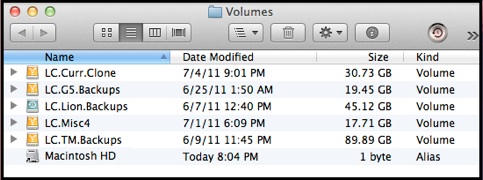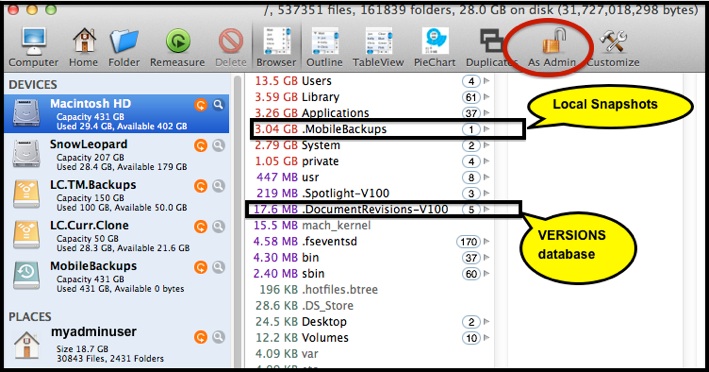OSX Tips
Where did my Disk Space go?
Several things can unexpectedly take a lot of disk space that often won't show up via normal use of the Finder. Some vary by OSX version. (If you're not sure what version you're on, click here).
Some of the usual suspects are:
A "false volume" in the hidden /Volumes folder.

Go > Go to Folder:


(If there's a MobileBackups folder, those are Time Machine's Local Snapshots. Leave it alone; see Time Machine FAQ #30.)

If in doubt, control-click (right-click) any and select Get Info. That panel will show Volume or Alias for the Kind.
If you find an actual Folder, that's likely the problem. Examine the contents to see if it's something you need; if not, delete it and empty the trash.
There are several possible causes of this:
•Sometimes when OSX loses track of a drive at just the wrong time, the app or process then creates a folder and writes the data there, instead of to the drive or partition. This happens on occasion with the "cloning" apps CarbonCopyCloner and SuperDuper.
•If you try to restore your entire HD from Time Machine backups by selecting the HD in the "Star Wars" display and clicking Restore, instead of using the procedure in Time Machine FAQ #14, the items will be restored to the /Volumes folder, not where you expect.
•If you restore from the Time Machine backups of a disk/partition that's no longer connected, and choose the Recreate Enclosing Folders option, instead of restoring to an alternate location, per Time Machine FAQs #15 and #16.
Other large files are different for each user, so not as easy to find. Once you've checked the things above, you'll need to use the Finder or a 3rd-party app to try to find what's using your disk space.
If you're here, you probably tried using the Finder already, and have noted that the folders you can see on your internal HD don't add up to the total used on the drive. There are two reasons for that:
•Hidden system folders. Your Mac has several hidden system folders. Most, but not all, of the ones that sometimes contain large unexplained files are covered by the items above.
•Other users' home folders. One user, even an Admin user, doesn't normally have access to other users' data, and that includes seeing the size of them.
So, if you have multiple users, log on to each one and check the size of their home folders. That can be rather tedious, of course, and still may not show what you want in a format that's helpful.
There are several 3rd-party tools to show what's using your disk space.
There are some free ones, including Disk Inventory X, OmniDiskSweeper, Grand Perspective, and SupaView. If you use one of them, log on to each user account to see the size of its home folder and add it to the total.
However, they won’t show all hidden system folders (where problems can occur). And nothing purchased from the Mac App Store will, either.
Especially on Lion 10.7.x or later, consider the green box below:
System Work Files, mainly Virtual Memory Swap files and the sleepimage file on laptops. From a Finder menubar, select Go > Go to Folder and type /var/vm in the prompt (you must include the slashes). You should see the following files:
•swapfile0 and perhaps one or more swapfile1, swapfile2, etc. These are used by OSX when your Mac needs more RAM (memory) than you have, so it "swaps" the contents of sections of memory out to disk temporarily so another process can use it. These start at 67 MB, then get progressively larger if more are needed. If you have a large number of them, and the total size is several GBs, you may need to consider getting more memory and/or running fewer applications at the same time, or you may have an app with a "memory leak" (not releasing memory that is no longer needed). Restarting your Mac will delete all but the first one or two, at least for a while.
•sleepimage is used on laptops to hold the contents of your RAM so it can be powered-off during sleep. It is read back in when your Mac awakens. It may be as large as your installed RAM.
QUICKIES:
•Empty the Trash. Seems obvious, but easy to forget.
Also . . . iPhoto has separate trash that must be emptied separately (via the iPhoto menubar).
•Restart your Mac. That will delete and re-create virtual memory files, etc.
•If you have a Laptop running Lion 10.7.x or later and using Time Machine, Local snapshots may take up a lot of space (but won't fill your HD past 80%). Note that they're not counted by the Finder (including Get Info on your HD), but are counted by Disk Utility and have a separate category on the Storage Display. See the pink box in Time Machine FAQ #30 and/or the green box below for details.
•Very large Log Files caused by repeated messages from a failing system process, or logs that haven't been "rotated" in a very long time. See the green box in OSX Log Files.
•Verify your internal HD, per #6 in Using Disk Utility. Directory problems can cause inaccurate sizes to be shown.
•Mobile Device Backups, in /Library/Application Support/MobileSync/Backup
The TechTools Directory Protection feature may put some very large files in your /Library/Application Support/Techtools Protection folder. If you have your data backed-up (as you should), this may not be worthwhile. But if you do use it, be sure to exclude your backup volumes, especially Time Machine backups.
The WhatSize app is similar to the free ones mentioned, and has a free trial, but it may be worth the $12.99 U.S. to get the paid version, for the following features:
•It seems to be the only one with an option to show everything at once; the others only show things the logged-on user is permitted to see. Effective with Lion, there are things no user is allowed to see, and sometimes they get out of hand.
•You can use any of 4 different display formats (3 text and a pie chart).
•There's a "Find Duplicates" feature.
•It has very good and complete Help.
For the purpose here, the ability to see everything, and at once, is critical -- some big files may be in hidden folders, that users normally can't see.
NOTE: do NOT purchase from the App store -- that version does not have the "As Admin" option, and it cannot be added. Get it only directly from http://whatsizemac.com/.
When the app starts, click the As User padlock in the toolbar. When you enter your Admin password, it will open and change to As Admin. (If you don't do that first, then be sure to "remeasure" afterwards.) Then select your internal HD in the sidebar and click the orange icon to measure it. That may take a while, of course. Here's a sample of the first window, after measuring the internal HD:

(Note: there's a discrepancy between the size shown in the sidebar and at the top, and the status bar at the bottom that's not shown in the sample; that's because one counts the number of blocks used, the other counts actual bytes.)
Look at the first column; it shows the top-level folders (many are normally hidden), with the largest ones first. Click the triangle at the right to see the next level, etc.
Some items that are covered above:
•private/var/log contains log files. See the green box in OSX Log Files.
•private/var/vm contains system "swap" files. See the pink box above.
•Volumes may contain a "false volume." See the blue box above.
•.MobileBackups (effective with Lion 10.7.x) contains Time Machine's Local Snapshots. See Time Machine FAQ #30. Oddly, it’s also shown separately in the sidebar, but the size there is meaningless (it shows the entire size of the internal HD both as capacity and used!).
Another you might find (effective with Lion 10.7.x):
•.DocumentRevisions-V100 This is the Versions database. There doesn't seem to be any easy way to determine what's using it's space, so about all you can do is examine files that you've edited using apps that support AutoSave and Versions. Common ones are TextEdit, Preview, Pages, and Numbers. Suspects would be large files and those you've edited a lot. Click the file name in the menubar (or the little triangle to the right of it, if it's visible) to enter the Versions browser. See OS X Lion: About Auto Save and Versions for details on using the browser.
While each version looks like a whole separate file in the browser, it isn't. The file itself contains only the current version; all other versions are actually the changed "chunks," kept in the .DocumentRevisions-V100 folder.
Versions made automatically are reduced to one per day after 24 hours, then one per week after a month, but that doesn't happen with versions you’ve made deliberately. If you see too many versions, especially of large files you've done a lot of editing on, you can delete individual versions, or all old ones, via the browser (click the title of a version on the right for the option to delete it, or Option-click for the option to delete all old ones).
Note: Do NOT delete the .DocumentRevisions-V101 folder -- that will delete all old versions and disable Versions entirely until the next Restart.
(I have no connection to the authors of this software, and receive nothing for the recommendation.)
Do NOT mess with anything you don't normally see, unless you fully understand it, or as noted here -- such items are hidden for a very good reason! They're critical system stuff. Deleting the wrong thing can make your system unusable!